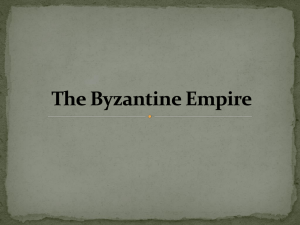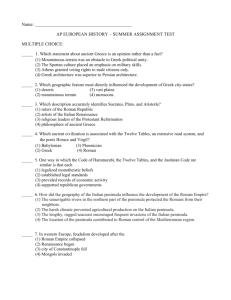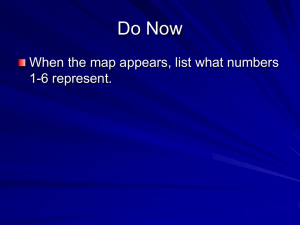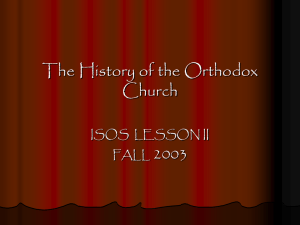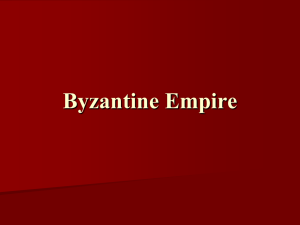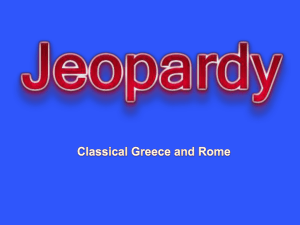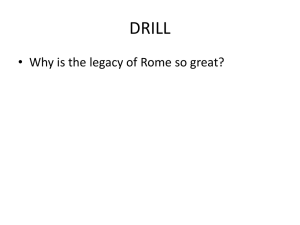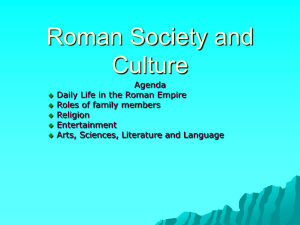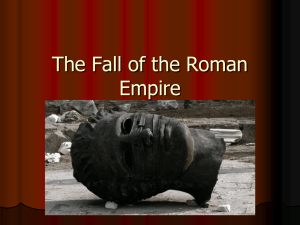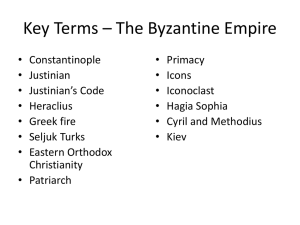The Dark Ages To The Renaissance
advertisement
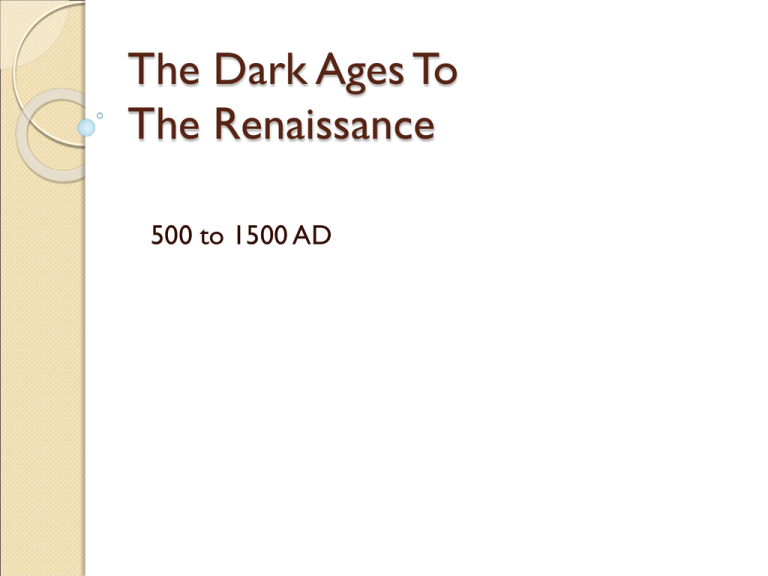
The Dark Ages To The Renaissance 500 to 1500 AD Iconoclastic Conflict Related to Church-State conflict 726 -843 AD Latourette pages 292-297 Emperors (Leo etc.) against icons in worship Clergy, particularly Greek clergy, were for icons in worship, also women in favor of… Icons a popular way of instructing the illiterate but became objects of veneration 2nd commandment was against images… Pro-icons – sense of historical faith Against icons (iconoclasts) neo-Platonist, Origenist, Christianity stood outside history… 7th Ecumenical council in 787 AD approved icons but regulated how they should be honored… finally resolved in 843AD Eastern Church – no sculpted or 3D images, just 2D paintings Allegorical Interpretation Origen – three levels of Scripture interpretation: Common / Historical – surface meaning for even the ‘simple-minded’ Soul of Scripture – which edifies those that perceive it Hidden Meaning – lying beneath the surface of difficult or morally / intellectually repugnant passages and which can be exposed by allegory ‘for the perfect’. Allegory helps perfect a person in Christ…. Related to typology – OT is a ‘type’ and NT the antitype Commonly used in the Middle Ages Collapse Of The Roman Empire Latourette pages 269-274 Enemies of Roman Empire In the North & West – Germanic tribes, Huns, Goths,Visigoths etc 476 AD end of the Western Empire Enemies In the South and East – Islam Corruption in the State and in the Church Over-identification of Christianity with Greco-Roman thought and culture Yet also saw the conversion of Clovis, King of the Franks and of many Germanic tribes. The Great Recession – many formerly Christian lands became Muslim or pagan. The Rise Of The Papacy Latourette pages 336-341 Rome rises to first place among the five main bishops – Jerusalem, Antioch, Constantinople, Rome and Alexandria As Rome and the Western Empire is abandoned by the Emperor and invaded by the Germanic tribes the Pope is the only societal leader Gregory the Great stabilizes Rome and sets the model for the papacy Roman practical and administrative skill gave it and edge over the more ‘spiritually-minded’ patriarchates Bold theological claims to power and legitimacy and to authority over the life of the believer Monasticism -1 Latourette p. 331-336 Monks and nuns and friars were an important part of medieval life Desert Fathers – Anthony the Great, Pachomius etc – known as Eremitic monasteries, unstructured, often solitary Cassiodorus – learning, manuscripts, structure introduced – Cenobitic monasteries with an abbot in charge Ireland – monasticism was the dominant expression of Christianity, scholarly copied many manuscripts Irish monks travelled all over Europe, and even to Iceland and were powerful evangelists The Irish annoyed the established Church in Europe as they were wanderers and did not ‘fit in’ Monasticism - 2 Benedict of Nursia – Rule of Benedict, cenobitic (structured, communal) monasticism is defined Head was an Abbot (from Abba as in father) and various officers Community was to be self-supporting Prayer, work and study Orderly lifestyle amidst chaos, widely admired 24 hrs a day was planned in some way (though not overly difficult or harsh). Idleness was an enemy of the soul Monks were ‘kept from contact with the world’ The East-West Split - 1 Tensions built between the Eastern & Western sections of the Roman Empire for centuries over questions of theology, church structure and administration and the role of the Bishop of Rome. 1014 AD the Roman Catholic Church (known then as the Western or Roman Church) added the words ‘and the Son’ to the Nicene Creed (in the section about the Holy Spirit) without consulting the Eastern Church (Bishop of Constantinople). In 1054 AD the two main Bishops (Rome and Constantinople) excommunicated each other The East-West Split - 2 After the split the Catholic church became split into the Roman catholic Church (based out of Rome) and the Orthodox Church (based out of Constantinople) The Orthodox Church continues today as the Greek Orthodox, Russian orthodox etc. The Orthodox churches are regional and are all in communion with one another – that is a Greek Orthodox is welcome in a Russian Orthodox Church etc. There were various attempts at reconciliation but none was truly successful. The Nicene Creed issue and the Roman Catholic claims about the papacy stand in the way. The East-West Split - 3 The Eastern Church (Constantinople) has some unique doctrines such as chrismation (like confirmation but involves anointing) Veneration (but not worship) of icons Emphasizes the divinity of Jesus Emphasizes our participation in the nature of God, especially via contemplation Likeness to God is the aim ( not just salvation) Theosis – becoming like God Three Stages: Purification, Illumination, Theosis The Crusades - 1 Latourette – p. 407-414 Islam – 622 AD Mohammed moves to Mecca By 650-670 most of North Africa and the Middle East subdued under Islam including the Nestorian and Arian Christians Conquered Spain in the 600s and 700s and threatened Constantinople In 1096 there was a call from Constantinople for help against the Seljuk Turks. Forgiveness of sins and eternal life promised to those who took part The Crusades - 2 1096 – First Crusade eventually a success, captures Jerusalem 1144 – Second Crusade organized after the fall of Edessa, a poorly organized failure 1187 – well organized Muslim armies under Saladin destroy the Crusaders 1189 – Third crusade, very costly, recaptures Acre 1202 - Fourth Crusade , plundered Constantinople for gain (sponsored by merchants from the city of Venice) Made matters worse between Roman catholic & Orthodox Christians Various other Crusades – also generally failed Need BOTH piety and logistics for success! Indulgences Started off as applying ‘the merit of the saints’ to sins in this life with genuine repentance required Remission of the good works required of penitent sinners in satisfaction for their offenses. Then became able to be ‘earned’ by participating in Crusades – and eventually by paying money Eventually indulgences applied to souls in purgatory (but not Hell) in order to shorten their stay there. Plenary indulgences – remission of all the temporal penalties for sins Eventually became abused as a ‘license to sin’ and led to the Reformation The Mongols Genghis Khan (Universal Emperor) 12th and 13th centuries (Latourette p. 383-384) Mongols – largest land empire ever! Sweep down from Mongolia, conquer Russia, China, Central Asia, Arabia and even reach as far as Vienna, Austria in Europe. Even threaten Japan Stopped just outside Nazareth Influence in India lasted until the 19th century Ruined large tracts of central Asia to this day! Was not hostile to Christianity, Christian faith flourished in China at this time 1368 break up of Mongol Empire, Ming Dynasty, takes over, anti-foreign, Christianity completely eradicated from China The Plague Around 1350 Bubonic Plague reduced the population of Europe by a third and that of England by a half Continued on and off for hundreds of years Unable to resist the rise of Turkish and Muslim armies Decimated the missionary orders – the Franciscans and the Dominicans Monasteries forced to accept inferior candidates Labor is short supply – spelled the end of serfdom and of feudalism Plague lead to widespread questioning of the faith for many lay people The Rise of Literacy Rediscovery of Greek bible manuscripts Translation of the Scriptures into the vernacular Increased art, education, especially with the Renaissance The invention of the printing press Relative prosperity meant many more people could be educated The Long Decline From 500 to 950 the Church went into serious decline From 950 to 1350 it saw some growth and resurgence through monasticism and by pushing Islam back From 1350 to 1500 it went into even deeper decline and by 1350 was far, far, worse off than it had been in 500 AD. The mixture of Christian Church + Roman State + Greek Culture was toxic to the Church! The Church needs to be independent of the State and the Culture Church was now doctrinally astray and materially corrupt – and God was going to change it!

